How to create and use a timesheet in a company?

There are many ways to approach working time tracking in project management.
The timesheet is a must.
What is a timesheet?
You probably already know what a timesheet is for, and we're willing to bet you've used it before, one way or another.
Timesheet: definition
The term "timesheet" means nothing less than "timesheet".
An integral part of time and activity management it's all about - surprise, surprise : a sheet enabling employees to annotate their working hours.
Often associated as a monitoring tool by employees, timesheet recording is often an administrative exercise perceived as painful.
The less clear and faster the time entry processes are – or even completely automated, the higher the risk of secondment, forgotten sending or data entry errors, impacting the proper management of the activity.
This can have a negative impact on employer credibility when invoicing is at stake.
Why use timesheets in business?
Beyond the assurance it represents for employees and the respect of their rights regarding time worked, this follow-up is required for strategic growth reasons such as optimizing resource planning - resulting in higher productivity and performance, but also for billing purposes, in the case of projects invoiced to the customer.
The timesheet then proves to be a real tool for optimizing financial performance, since it allows you to obtain a clear vision of the distribution of resources in time over tasks.
As a result, it becomes easier to identify the best profiles to mobilize on certain types of project, and to optimize your utilization rate to maximize occupancy on profit-generating assignments.
On the HR side, monitoring the performance of teams and employees makes it possible to develop relevant development plans, based on existing data from past projects.
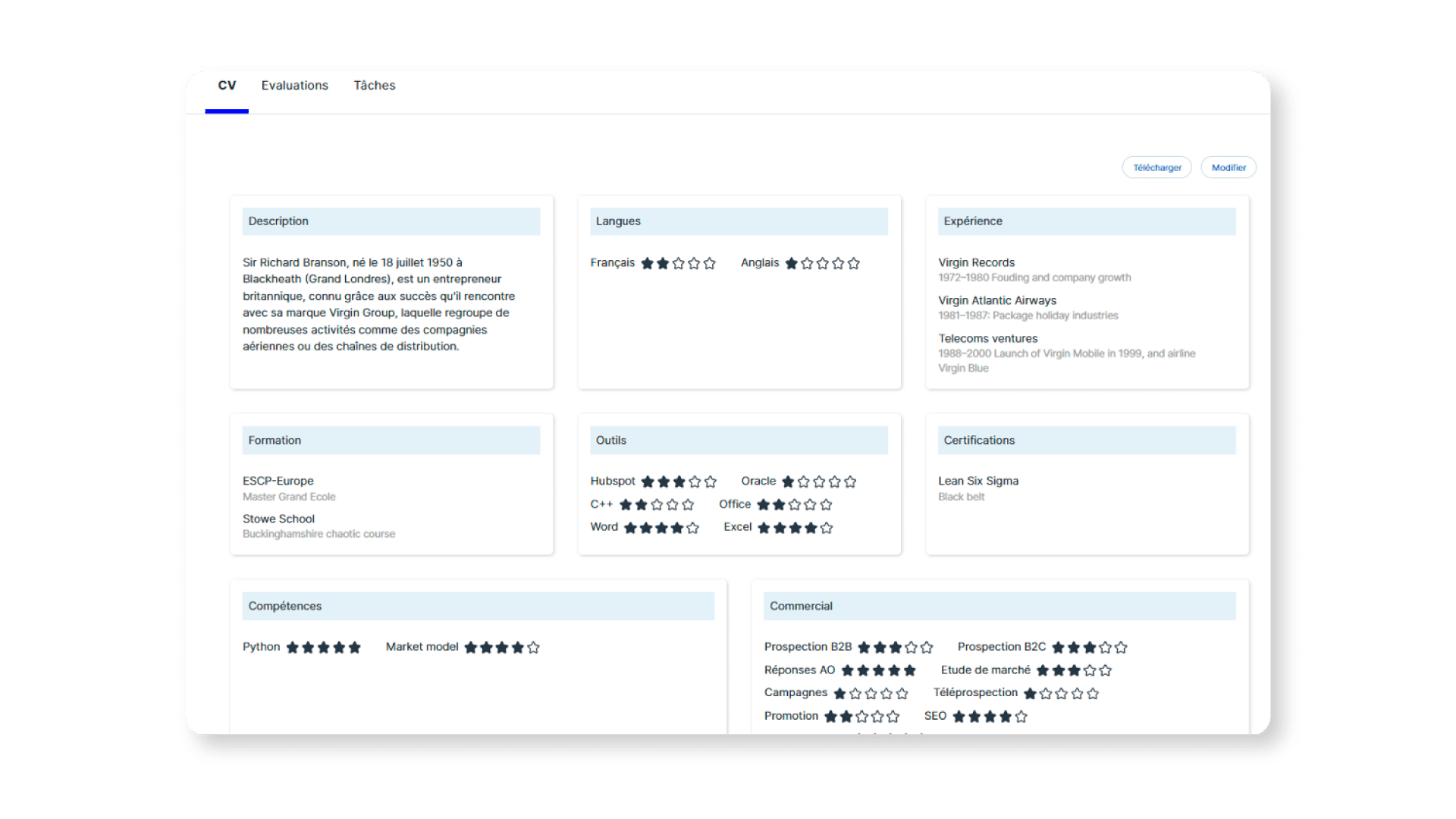
Stafiz allows skills management in its HR module.
The profile elements are customizable, and each user can annotate the skills he or she wants to develop.
These elements can be discussed during annual interviews, and updated in the profile once the skill has been acquired.
Finally, the timesheet allows for much more precise and justifiable invoicing in the case of projects sold by a direct contractor.
Which medium should I choose to set up timesheets?
Plot twist: the timesheet is not condemned to be presented in the form of a sheet!
It is available in a wide range of formats to suit all types of industry, in a context of digital transformation.
The paper timesheet
For the nostalgic or the more manual among us, the paper format can do the job very well.
- The benefits
The easiest solution to implement, without dispute.
This free timesheet has no deployment or maintenance costs - if, however, you consider a pack of sheets and a few pens to be purchased material..
It will adapt to all your employees: intuitive and fast, it does not require any technical skills, and can be flexibly adapted to the needs of the company.
- Limitations
While this method may be suitable for a small company or within a department, it is more restrictive on a large scale.
Papers are lost and degraded more easily. The problems related to forgetting or data entry errors therefore remain topical.
This materialized approach also adds more difficulty in the monitoring and analysis process : the data is processed one by one and by hand. Sheets may be delivered in installments (when delivered), and physical storage is cumbersome.
Use Excel as a timesheet
Recording working time in Excel is quite suitable for creating and monitoring timesheets.
- The benefits
As a spreadsheet star, your employees are probably already familiar with Excel or similar software such as Google Sheets or Numbers.
Accessible on the cloud, the information is centralized, so there is no need to provide a sheet per employee or team.
A formula to calculate them all: spreadsheets offer a high degree of customizability, allowing you to automate your calculations and save precious time.
- Limitations
While the tracking is automated, the time recording is not. Input is an effort that is sometimes postponed to a later date, which can lead to input errors or inconsistencies.
Anyone's access to the timesheet array can lead to unintentional changes to the implemented functions that can corrupt the file.
Finally, the more teams there are or have specificities, the more difficult time management will be.
The use of a time clock
Time clocking is a way of to record working hours with great precision.
However, can it respond to time management issues?
- The benefits
Employers require little effort, so the risk of dissatisfaction and negligence is virtually eliminated.
Management is also simplified due to the automation of data collection.
- Limitations
This approach leaves little room for flexibility: forget about remote days and off-site collaboration.
Forgot or lost the badge? The return to the manual solution is necessary, which can create integration problems on the tracking system.
Installation and maintenance costs are high, and malfunctions can distort data.
Finally, this method does not allow for precise segmentation by task or project. It is difficult to analyse production without taking into account the reality on the ground.
Use timesheet software
The online timesheet seems to combine the strengths of different timesheet mediums into one tool.
- The benefits
A real time clock software combined more widely with the time management application, the timesheet tool allows for more reliable time tracking.
Among the key features, the ability to create validation steps is a way of securing entries in the event of an inspection.
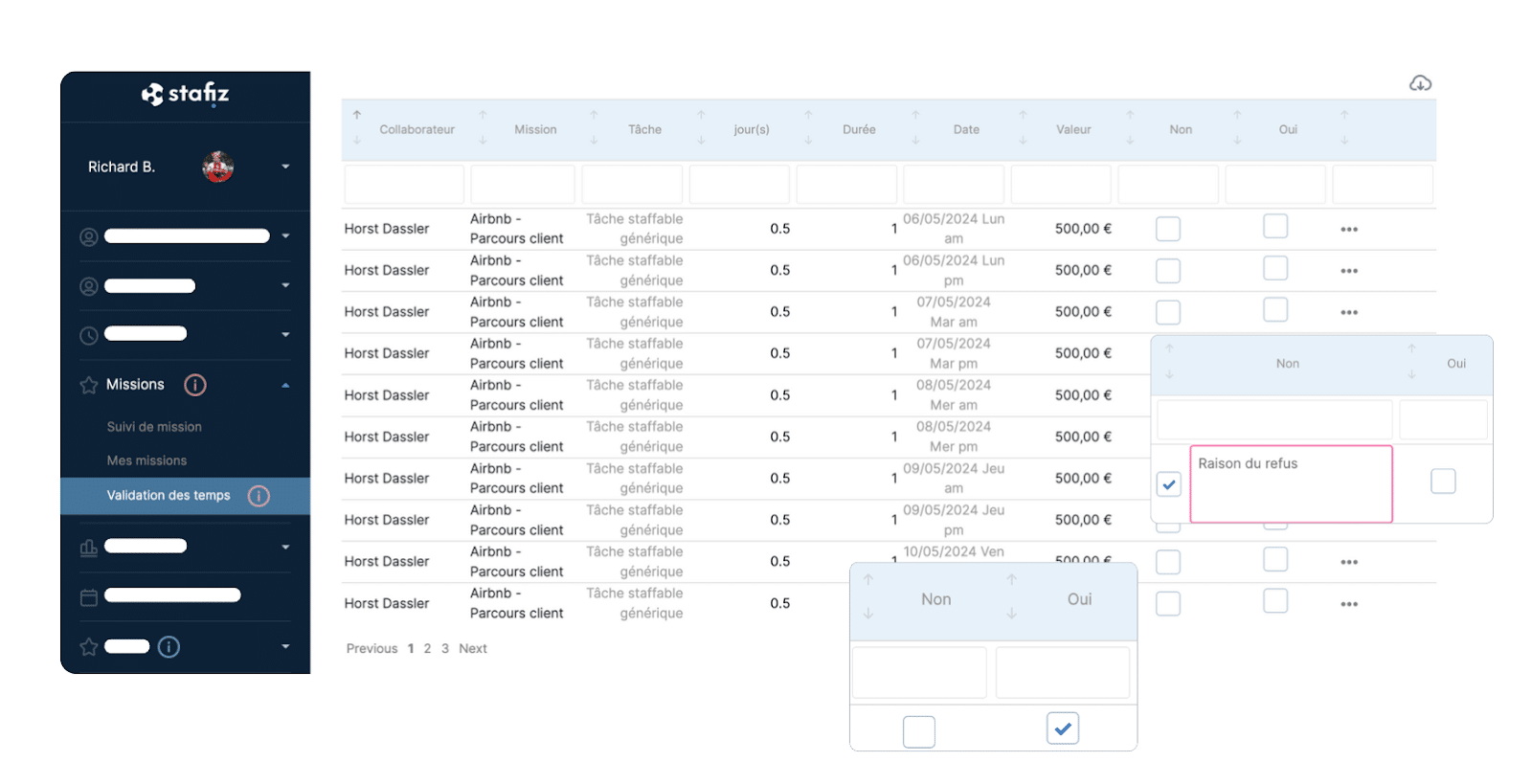
Times are easily segmented into categories for understandable graphical reports in an instant.
Some software allows live time recording through a stopwatch for example.
- Limitations
This time saving on the entry of timesheets and their follow-up has a greater cost than a physical or spreadsheet method.
Some providers do not offer onboarding or training services. The process of choosing a tool can therefore take time to avoid wasting time with an unsuitable choice.
The timesheet software should also be easy enough to use so as not to discourage employee use.
A lack of integrations with your other management systems is a penalty that must be expected.
How do I create a timesheet?
While the concept is clear and quite meaningful to you, it's natural to wonder what parameters will make up your timesheet.
To create an effective, readable timesheet that is consistent with your strategic objectives, follow our step-by-step action plan.
Step 1: Choose your timesheet format
As seen above, there are different mediums for conceptualizing your timesheets.
One is not necessarily better than the others. Several criteria must be studied to adapt to YOUR current use case.
You can adapt your solution or change it as soon as the need arises.
- Which method for which size of company?
Rather a small team or a well-implemented group? The number of employees involved in your time management can depend on both the maturity of your business and your business model.
The more a company grows, the more the need for automation and advanced technology becomes.
- What is the budget for a timesheet software?
More or less correlated with your maturity and the resources available, the implementation budget is an important criterion.
Investing in an overly elaborate and expensive solution can be counterproductive on a small scale. Just make sure to adapt or change the tool to respect your growth.
- Which solution for what objectives?
If your main concern is to analyze in-house time allocation to certain tasks or projects, there's no need for a multi-featured solution.
If you want to reduce the time allocated to your invoicing, you want to be able to use your timesheets as a reference, allowing you to automatically fill in your invoices.
To optimize financial performance, timesheet software is essential. Stafiz makes it possible to gain in efficiency in the allocation of resources by taking into account the current and future availability of employees, their skills, but also their preferences.
Step 2: Set up time tracking
Companies can have different approaches to time management. The sale of consulting assignments or services can be on an hour, day or half-day basis.
Some employees may benefit from special contracts, such as part-time work, which impacts reporting and data analysis particularly when monitoring of utilization rate.
For example, it is necessary to be able to consider the utilization rate of a full-time employee. Thus, for a total of 20 hours, he or she will have a rate of 100% compared to 57.1% for a colleague with a 35-hour contract.
To best represent reality, integrate rules that allow:
- legal compliance with the maximum permitted working hours (breaks, hours of a day);
- the inclusion of employee absences, regardless of their nature (paid or unpaid leave, work stoppage).
Step 3: Categorize tenses
To optimize your production through efficient tracking, segment times precisely to get a comprehensive view of how employee time is being used.
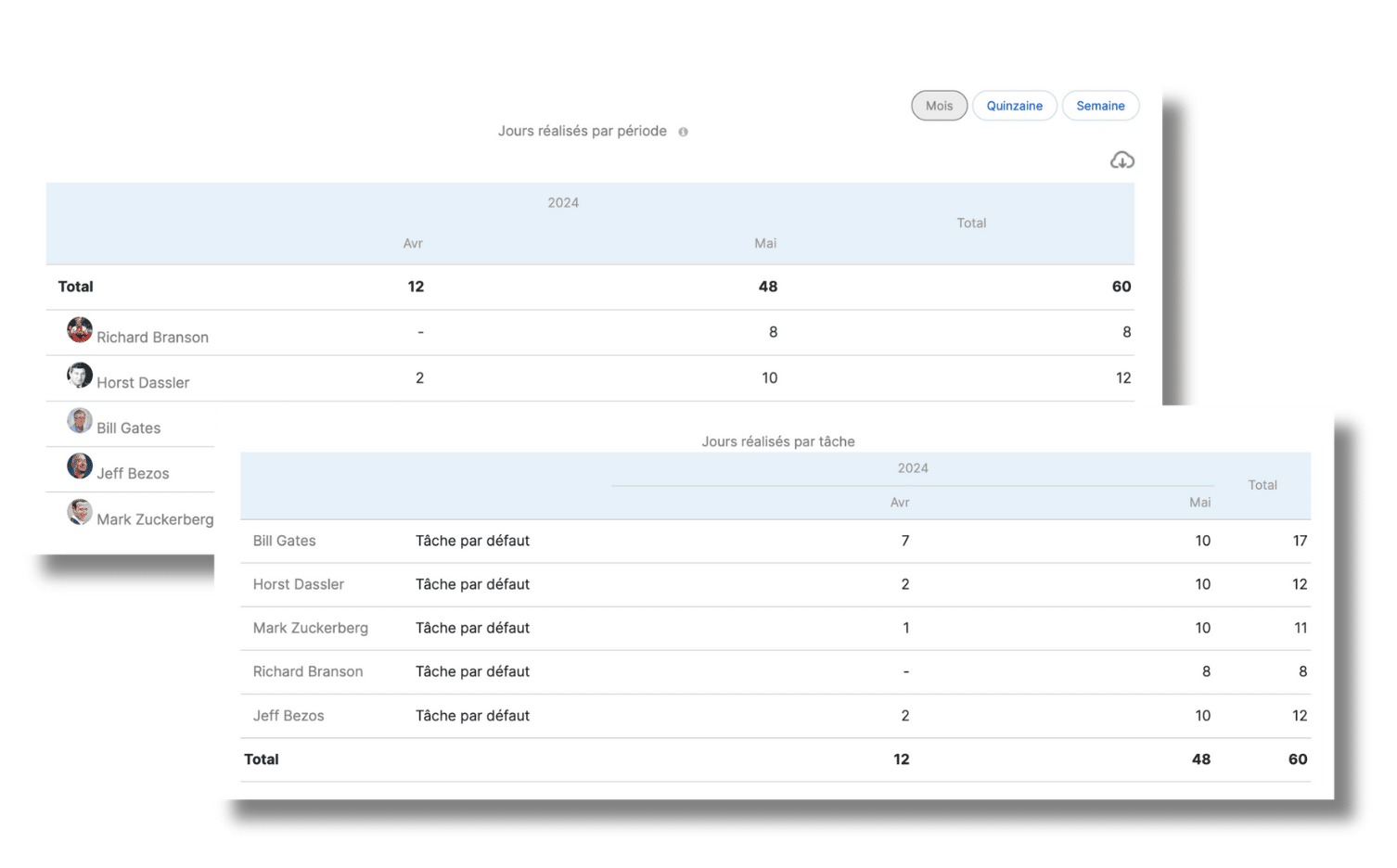
To label them, it's up to you to identify the elements to be tracked according to your organization.
Some examples of categories:
- programmes and projects;
- Phases, tasks, and subtasks
- internal projects (training, R&D, administrative tasks, etc.);
- training;
- Teams, business units and departments.
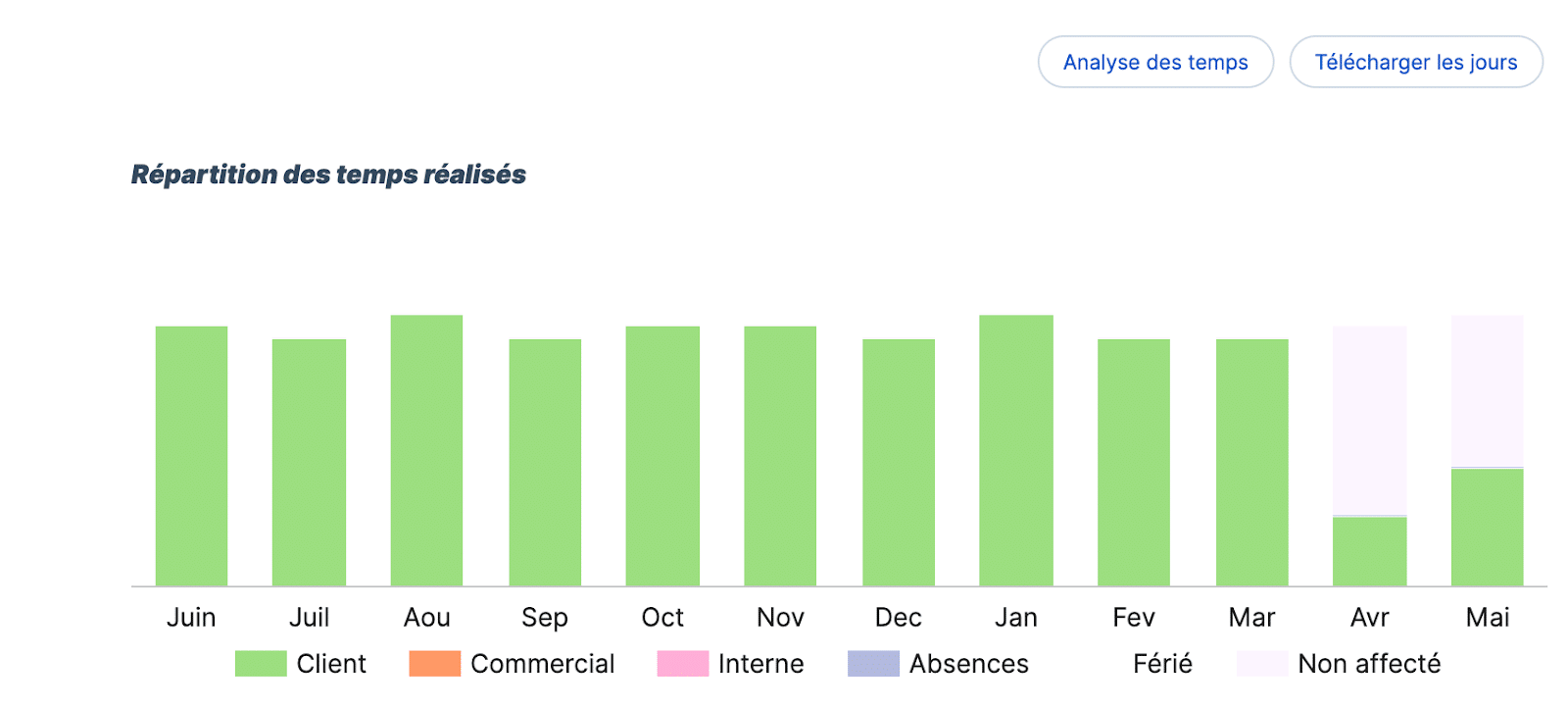
Thanks to timesheets, Stafiz creates a report that allows you to track time and activities in detail.
Step 4: Include cost management
For study your profitability or to prepare customer invoices, you can integrate the hourly rate for each employee into your timesheets.
In the case of paper timesheets, arm yourself with your calculator.
In Excel, add up the totals, remembering to include the specifics of hourly rates for invoicing.
On dedicated software, financial data is automatically calculated according to the times entered on the timesheets. Track your margins and project progress in real time.
Stafiz automates your invoicing by retrieving data from your timesheets to calculate the cost of customer invoices
How do you analyze a timesheet?
Apart from invoicing, timesheets are intended to be read, interpreted and challenged to optimize productivity within the organization.
Being able to identify which tasks are the most time-consuming, or which deserve more attention, is a way of reporting back to management on the reality in practice, and of being able to put into action solutions to overcome blocking situations.
Spot discrepancies with forward planning
Discrepancies between the initial schedule and the times recorded on the timesheet is the first warning sign.
Using integrated software, this comparison can be illustrated graphically. It is an impactful way to identify deviations as early as possible in the execution of the project in order to take corrective measures quickly.
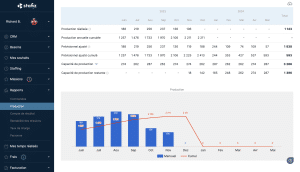
Production report: gaps between objectives and achievements.
Do a financial analysis
Beyond timesheets, Stafiz integrates the management of associated budgets (with the management of CJMs and ADR).
This allows you to make a financial analysis of your business and anticipate when deviations will occur and act proactively by adapting the resource planning.
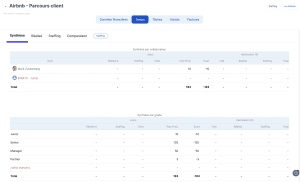
Comparison of the gaps between achieved and production objectives in Stafiz.
Establish regular follow-up
Setting up timesheets takes time, and it would be heartbreaking to invest in setting them up so as not to analyze them.
Once the timesheets have been created, it is necessary to make managers and teams responsible for their proper use, this involves regular monitoring.
This monitoring can take two forms.
You can schedule timesheet review meetings each month, or after a project closes.
Invite your employees to engage in a discussion about their feedback, discuss the goals, and of course, congratulate them on their efforts.
On a more recurring basis, generate automatic reports at the necessary cadence. This allows you to take a step back from daily real-time monitoring as well as prepare for your follow-up meetings.
Build a history
Take advantage of the reports generated by your timesheet software to build archives.
A real gold mine for monitoring your objectives, you have different metrics to obtain points of comparison to evaluate the effectiveness of the actions taken, and subsequently, improve your pricing.
It also supports strategic decision-making about your current and future resource capacity.

